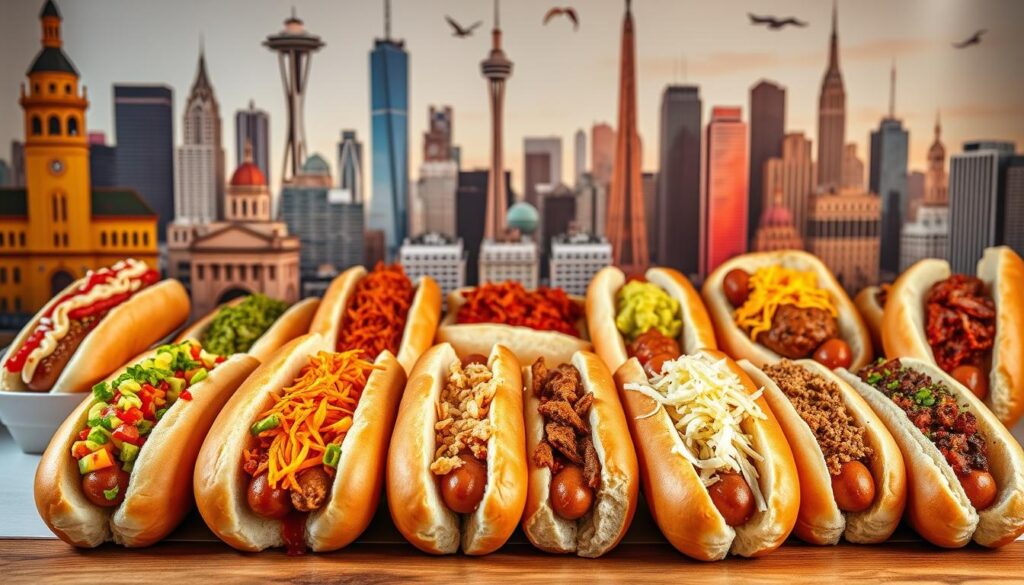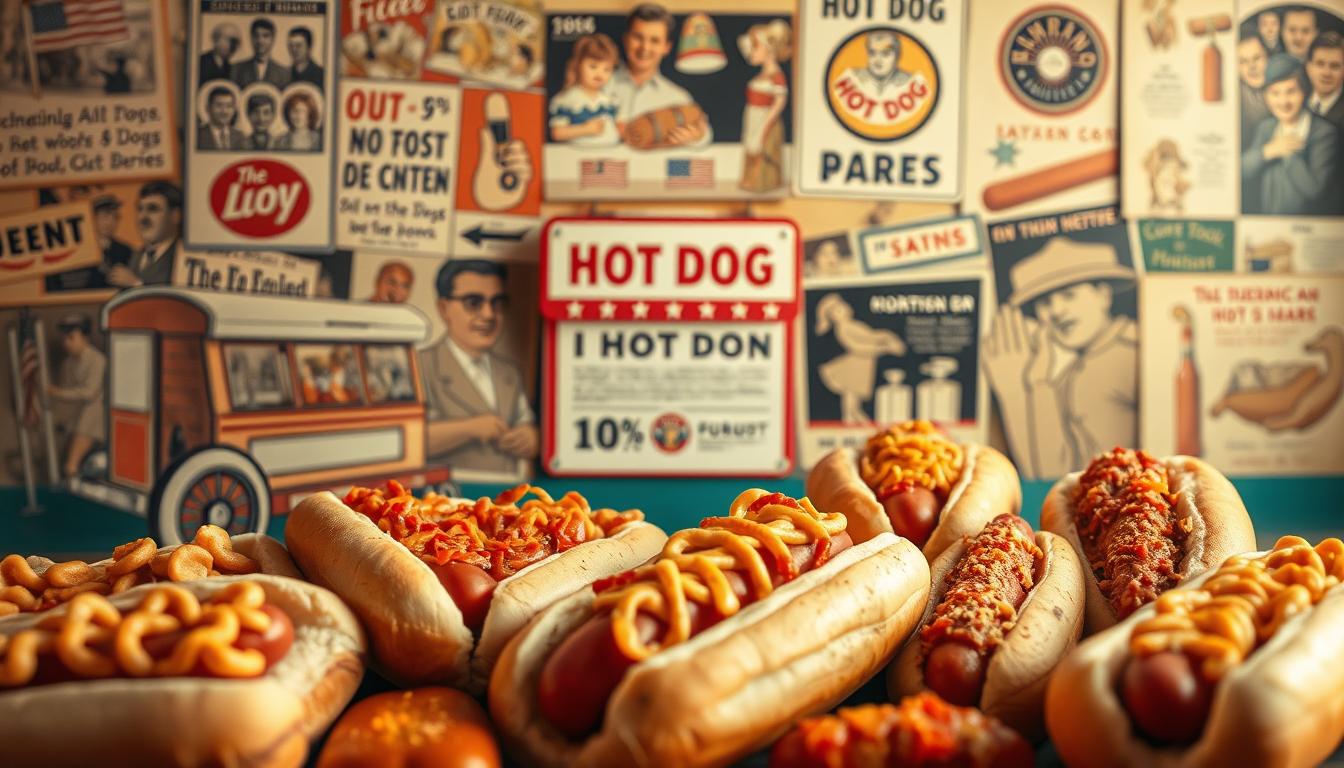The beloved street food has been a staple in American cuisine for over a century, with its origins dating back to European immigrants. This tasty treat has a rich cultural heritage that spans continents and communities.
From its early days as a simple sausage served in a bun to its current status as a customizable culinary delight, this classic dish has evolved significantly over time. With various toppings and condiments, it’s no wonder that it has become a favorite among people of all ages.
Key Takeaways
- Discover the European roots of this popular American food.
- Learn about the evolution of the classic dish over time.
- Explore the cultural significance of this street food.
- Uncover the interesting variations and toppings that have become a hallmark.
- Understand why this dish remains a staple in American cuisine.
The Origins of the Hot Dog
Tracing the origins of the hot dog takes us on a journey through time, from ancient civilizations to modern-day street vendors. The hot dog, as we know it today, is a culmination of various cultural and culinary influences.
Ancient Sausages and Their Influence
The concept of sausages dates back to ancient times. The earliest recorded evidence of sausage consumption comes from ancient Mesopotamia, around 1500 BCE. The practice of stuffing meat into casings was later adopted by the ancient Greeks and Romans, who are known to have consumed sausages at social gatherings.
A quote from the Roman cookbook “De Re Coquinaria” by Apicius highlights the importance of sausages in ancient Roman cuisine:
“Sausages were a staple in the Roman diet, often served at banquets and feasts.”
The Impact of German Immigrants
German immigrants played a significant role in shaping the modern hot dog. In the 18th and 19th centuries, many Germans traveled to the United States, bringing with them their sausage-making traditions. The frankfurter, a type of sausage named after Frankfurt am Main, became particularly popular.
The influence of German cuisine on the hot dog is evident in the various names associated with it, such as “frankfurter” and “wiener.” These names reflect the sausage’s origins and the cultural exchange that occurred between Germany and the United States.
| Region | Sausage Type | Influence on Hot Dog |
|---|---|---|
| Frankfurt, Germany | Frankfurter | Named after the city, reflecting its origins |
| Vienna, Austria | Wiener | Popularized in the U.S. as another name for hot dog |
| United States | Hot Dog | Adapted and popularized American-style |
The Street Vendor Connection
Street vendors were instrumental in popularizing the hot dog in the United States. In the late 19th and early 20th centuries, vendors in cities like New York and Chicago began selling hot dogs as a quick and affordable meal option.
The rise of street vendors selling hot dogs coincided with the growth of urban centers and the increasing demand for fast, convenient food. This connection between street vendors and the hot dog’s popularity is a crucial aspect of its history.
Naming the Hot Dog
Unraveling the story behind the hot dog’s name reveals a blend of historical facts and intriguing legends. The term “hot dog” has become synonymous with American cuisine, but its origins are rooted in a mix of cultural influences and historical events.

The Legend of Daniel Webster
One of the legends surrounding the naming of the hot dog involves Daniel Webster, a prominent American statesman. According to the tale, Webster’s love for the dachshund sausage, which was small and thin like a dachshund dog, led to the coining of the term “hot dog.” Although this story is often cited, its accuracy is debated among historians.
The true origin of the term “hot dog” is believed to have emerged in the late 19th or early 20th century in the United States. One popular theory is that it was coined by Charles Feltman, a German immigrant who opened a hot dog stand on Coney Island in 1871. Feltman’s innovation was serving sausages in rolls, making them a convenient and tasty snack for the masses.
Frankfurter vs. Wiener – What’s the Difference?
The terms “Frankfurter” and “Wiener” are often used interchangeably with “hot dog,” but they have distinct origins. A Frankfurter is a type of sausage that originated in Frankfurt, Germany, known for its pork content and specific seasoning. On the other hand, a Wiener, short for “Wiener Würstchen,” comes from Vienna, Austria, and is typically made from a mixture of pork and beef.
- Frankfurter: Originated in Frankfurt, Germany; typically made from pork.
- Wiener: Originated in Vienna, Austria; made from a mixture of pork and beef.
Understanding these differences adds depth to the appreciation of hot dog history and the cultural influences that have shaped this beloved dish. Whether you’re enjoying a classic ballpark frank or a gourmet variation, the story behind the name is as fascinating as the hot dog itself.
“The hot dog is a symbol of American culture, representing the country’s ability to take simple ingredients and turn them into a culinary icon.”
The Rise of the Hot Dog in America
The hot dog’s journey to becoming an American staple began with humble street vendors. These vendors played a crucial role in popularizing the hot dog, making it a convenient and affordable food option for the masses.
The First Hot Dog Stands
The first hot dog stands emerged in the late 19th and early 20th centuries, particularly in urban areas like New York City. Entrepreneurs like Charles Feltman, who opened a hot dog stand on Coney Island in 1871, are credited with introducing the hot dog to a wider audience. Feltman’s innovation was not just serving hot dogs but doing so in a way that was both clean and appealing to the masses.
Key milestones in the rise of hot dog stands include:
- The establishment of Feltman’s hot dog stand, which became a landmark on Coney Island.
- The introduction of the hot dog bun, which made consuming hot dogs more practical and less messy.
- The proliferation of hot dog stands in urban centers, making hot dogs a staple of American street food.
Hot Dogs at the Ballpark
The association of hot dogs with baseball is one of the most iconic aspects of American sports culture. The introduction of hot dogs to ballparks is often attributed to Nathan Handwerker, who in 1916, began serving hot dogs at Nathan’s Famous stand outside Ebbets Field in Brooklyn, New York. This move not only popularized hot dogs among baseball fans but also cemented their place in American sporting traditions.
| Year | Event | Location |
|---|---|---|
| 1871 | Charles Feltman opens a hot dog stand | Coney Island, New York |
| 1916 | Nathan Handwerker begins serving hot dogs outside Ebbets Field | Brooklyn, New York |
The rise of the hot dog in America is a testament to the power of cultural fusion and culinary innovation. From its origins with German immigrants to its popularization through street vendors and ballparks, the hot dog has become an integral part of American food culture.
Hot Dogs in Popular Culture
The hot dog is more than just a food item; it’s a cultural icon that has permeated various facets of American life. The hot dog’s presence in popular culture is undeniable, from its appearances in iconic movies to its role in sports traditions.
Iconic Movies Featuring Hot Dogs
Hot dogs have been featured in numerous iconic movies, often symbolizing American culture or serving as a nostalgic element. For instance, in E.T. the Extra-Terrestrial, Reese’s Pieces and hot dogs are among the treats that E.T. enjoys.
Some other notable movies that feature hot dogs include:
- The Sandlot – A coming-of-age baseball comedy where hot dogs are a staple at the ballpark.
- Elf – Will Ferrell’s character, Buddy, enjoys hot dogs with maple syrup, showcasing his childlike wonder.
The Hot Dog in Sports Traditions
Hot dogs are an integral part of the sports experience, particularly in baseball. The tradition of eating hot dogs at ballparks dates back to the early 20th century, with Nathan’s Famous Hot Dog Eating Contest being a highlight of the Fourth of July celebrations.
Sports stadiums across the United States have their own hot dog traditions, with some offering unique regional variations. For example:
| Stadium | Hot Dog Variation |
|---|---|
| Wrigley Field, Chicago | Chicago-style hot dogs with relish, onions, tomatoes, sport peppers, and pickle spear |
| Yankee Stadium, New York | Classic New York-style hot dogs with sauerkraut and grilled onions |
Famous Hot Dog Competitions
Hot dog competitions have become a staple of American culture, showcasing the country’s diverse love for hot dogs. These events range from casual gatherings at local eateries to internationally recognized contests that draw competitors and spectators from around the globe.
Nathan’s Famous Hot Dog Eating Contest
The most iconic of these competitions is undoubtedly Nathan’s Famous Hot Dog Eating Contest, held annually on Coney Island, Brooklyn. This contest has a rich history, dating back to 1916, and has been a platform for some of the world’s most renowned competitive eaters.
Key facts about Nathan’s Contest:
- Held every July 4th
- Competitors train extensively to increase their stomach capacity
- The contest has been won by legendary eaters like Joey Chestnut and Miki Sudo
Other Notable Hot Dog Competitions
While Nathan’s is the most famous, it’s not the only hot dog eating contest in the United States. Other notable competitions include:
| Contest Name | Location | Notable Feature |
|---|---|---|
| Major League Eating (MLE) Tournaments | Various locations | Part of a larger competitive eating tour |
| Chicago Street Dog Eating Contest | Chicago, IL | Features Chicago-style hot dogs |
| LA Hot Dog Eating Contest | Los Angeles, CA | Showcases a variety of gourmet hot dogs |
These competitions not only celebrate the hot dog but also contribute to the cultural fabric of their respective locations, often supporting local charities and businesses.
Regional Hot Dog Variations
Hot dogs have become a canvas for regional culinary creativity, reflecting local culture and preferences. This diversity is a testament to the hot dog’s versatility and its ability to adapt to different tastes and traditions.

Chicago-style Hot Dogs: A Local Delicacy
Chicago-style hot dogs are known for their distinctive preparation and toppings. Served on a poppy seed bun, these hot dogs are characterized by their all-beef frankfurter, yellow mustard, bright green relish, chopped white onions, sliced red tomatoes, a pickle spear, and a dash of celery salt. This combination creates a flavor profile that is both complex and harmonious.
The history of the Chicago-style hot dog is deeply rooted in the city’s cultural melting pot. It reflects the influence of various immigrant groups, particularly Germans and Eastern Europeans, who brought their sausage-making traditions to America.
New York Hot Dogs: The Classic Street Food
New York hot dogs, often served from street carts, embody the fast-paced and vibrant spirit of the city. Typically topped with sauerkraut or grilled onions and served with a side of spicy brown mustard, these hot dogs are a classic New York experience.
The appeal of New York hot dogs lies in their simplicity and the nostalgic value they hold for many New Yorkers. They represent a culinary tradition that has been passed down through generations, with each cart and restaurant offering its own take on this beloved dish.
Exploring regional hot dog variations like those in Chicago and New York reveals the rich tapestry of American food culture. Each region’s unique take on the hot dog not only showcases local flavors but also tells a story of cultural heritage and culinary innovation.
The Hot Dog Industry Today
As consumer preferences continue to shift, the hot dog industry is responding with innovative products and healthier options. This evolution is driven by consumer demand for more diverse and nutritious food choices.
The hot dog industry has seen significant growth in recent years, with major brands and producers leading the way. Companies like Oscar Mayer and Ball Park continue to dominate the market, offering a range of products that cater to different tastes and dietary needs.
Major Brands and Producers
Some of the key players in the hot dog industry include:
- Oscar Mayer
- Ball Park
- Nathan’s Famous
- Hebrew National
These brands have established themselves through a combination of quality products, effective marketing, and widespread distribution.
| Brand | Market Share | Notable Products |
|---|---|---|
| Oscar Mayer | Leading | Classic Wieners, Hot Dogs |
| Ball Park | Significant | Classic Franks, Bun-Length Franks |
| Nathan’s Famous | Recognized | Nathan’s Famous Hot Dogs |
Health Trends Influencing Hot Dogs
The hot dog industry is also being influenced by health trends, with consumers increasingly seeking out products that are lower in sodium, made with higher-quality meats, or are plant-based.
In response, many manufacturers are introducing healthier hot dog options, such as:
- Organic hot dogs
- Low-sodium hot dogs
- Plant-based hot dogs
The industry’s adaptation to these trends is not only a response to consumer demand but also an opportunity for innovation and growth.
Fun Hot Dog Facts You Didn’t Know
From the world’s longest hot dog to its connection with major celebrations, there are numerous fun facts about hot dogs waiting to be discovered. Hot dogs have been a staple in American cuisine for over a century, and their history is filled with intriguing stories and records.
The World’s Longest Hot Dog
In 2011, a team in Illinois achieved a remarkable feat by creating the world’s longest hot dog, measuring over 1,996 feet. This record-breaking hot dog was not only a testament to the creativity of the team but also highlighted the fun and competitive spirit associated with hot dog culture. 
Such records showcase the innovative and playful side of hot dog enthusiasts. The attempt to break this record continues to be a fun challenge for communities and organizations around the world.
Hot Dogs and the Fourth of July
Hot dogs are closely associated with American celebrations, particularly the Fourth of July. It’s estimated that Americans consume over 150 million hot dogs on this day alone. The tradition of eating hot dogs during Independence Day celebrations is a beloved custom that brings families and friends together.
The connection between hot dogs and the Fourth of July is more than just a culinary preference; it’s a part of historical hot dog trivia that reflects the cultural significance of this dish in American society.
These interesting hot dog facts demonstrate the impact and popularity of hot dogs in American culture, from record-breaking attempts to festive traditions.
Culinary Innovations: Beyond the Classic
Beyond the classic hot dog, culinary innovations are redefining this beloved dish. The evolution of hot dogs is not just about new toppings or condiments; it’s about reimagining the very essence of what a hot dog can be.
Gourmet and Specialty Hot Dogs
Gourmet hot dogs are gaining popularity, with restaurants and food stands offering unique variations that cater to diverse tastes. Some notable examples include:
- Lobster Dog: Featuring chunks of succulent lobster meat, this luxurious hot dog is a seafood lover’s dream.
- Mac ‘n Cheese Dog: This indulgent hot dog is topped with macaroni and cheese, adding a comforting twist.
- Chili Cheese Dog: A classic combination of chili and melted cheese, this hot dog is a staple at many ballparks and food festivals.
These gourmet options showcase the versatility of hot dogs, allowing chefs to experiment with a wide range of ingredients and flavors.
Vegan and Plant-Based Hot Dog Options
The rise of vegan and plant-based diets has led to the creation of hot dog alternatives that are just as delicious. Some popular vegan hot dog options include:
- Tofurky Hot Dogs: Made from tofu and spices, these hot dogs mimic the taste and texture of traditional hot dogs.
- Field Roast Hot Dogs: Known for their grain-based sausages, Field Roast offers a range of vegan hot dog options.
- Upton’s Naturals Hot Dogs: These plant-based hot dogs are made with a blend of grains and spices, offering a satisfying alternative.
These vegan and plant-based hot dogs are not only cruelty-free but also offer a healthier alternative to traditional hot dogs, catering to the growing demand for plant-based cuisine.
The culinary innovations in the world of hot dogs reflect a broader trend towards creativity and diversity in food culture. As consumers become more adventurous and health-conscious, the hot dog industry continues to evolve, offering something for everyone.
Conclusion: The Everlasting Appeal of Hot Dogs
The hot dog’s enduring popularity is a testament to its rich history and cultural significance. From its origins as a street food to its current status as a staple at ballparks and backyard barbecues, the hot dog has become an integral part of American cuisine.
Cultural Significance
Exploring hot dog history facts and hot dog culture history reveals the complexity of this seemingly simple dish. The hot dog has been shaped by various cultural influences, including German immigrants and street vendors, contributing to its unique identity.
A Beloved Dish
Some interesting hot dog facts highlight the creativity and diversity surrounding this beloved dish. Whether it’s a classic ballpark frank or a gourmet variation, the hot dog continues to captivate audiences across the United States, remaining a staple of American culture and cuisine.


